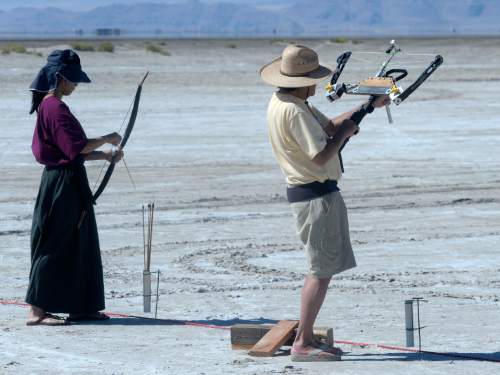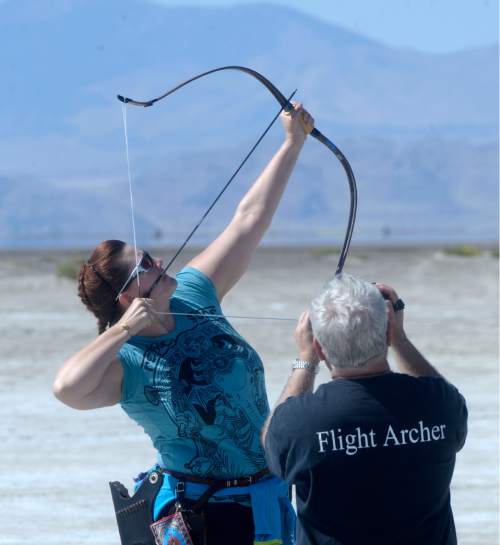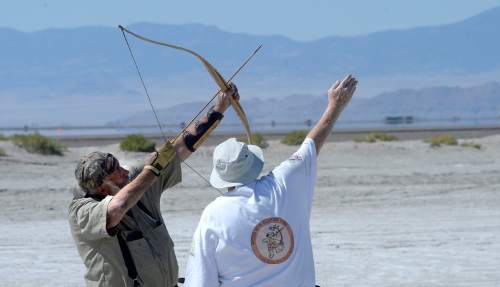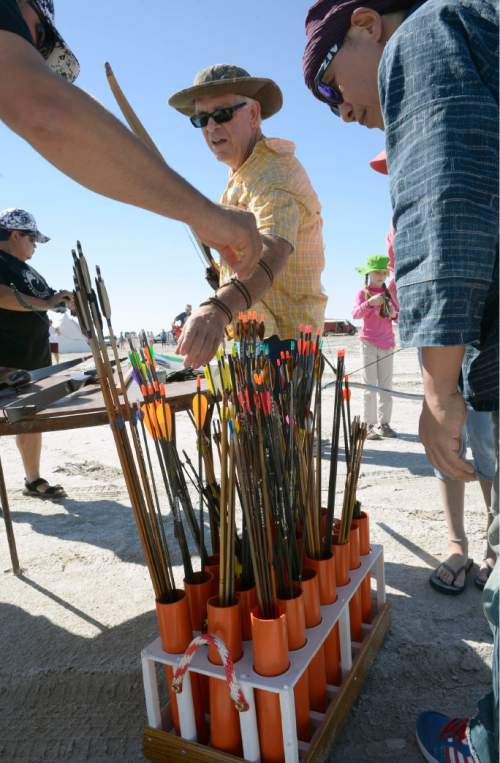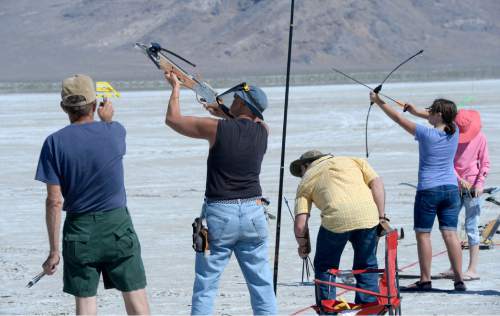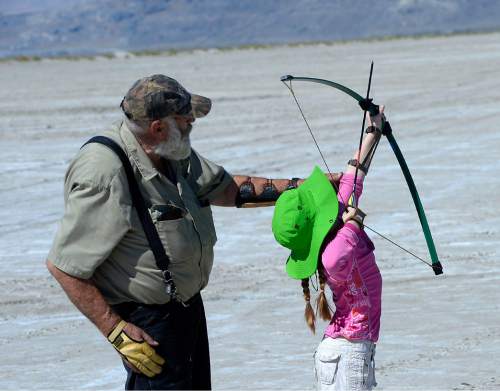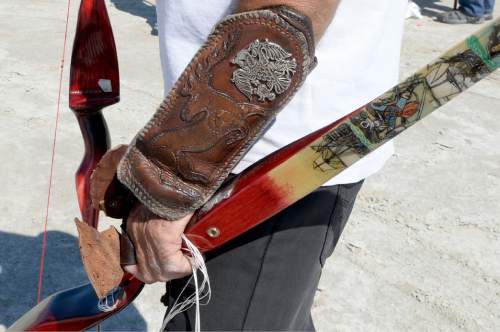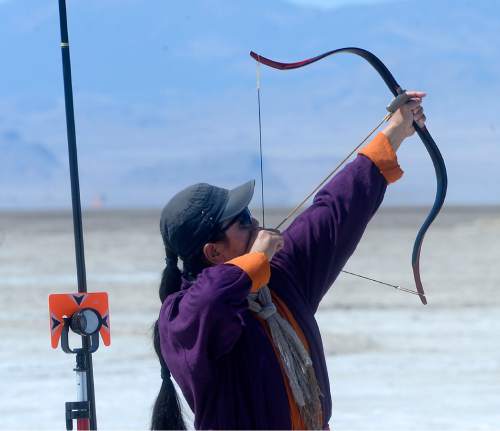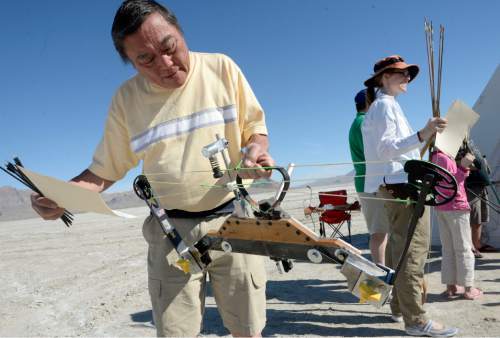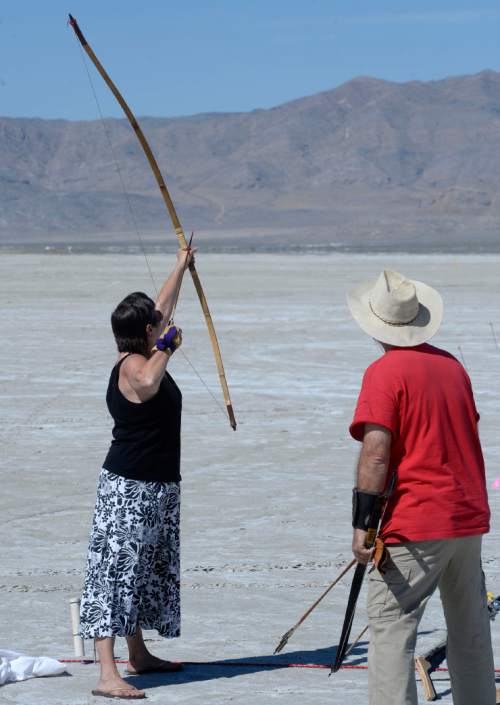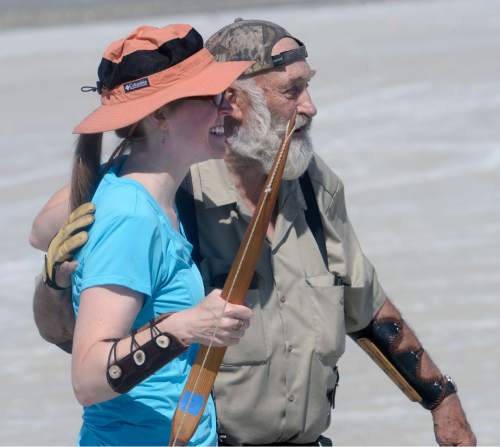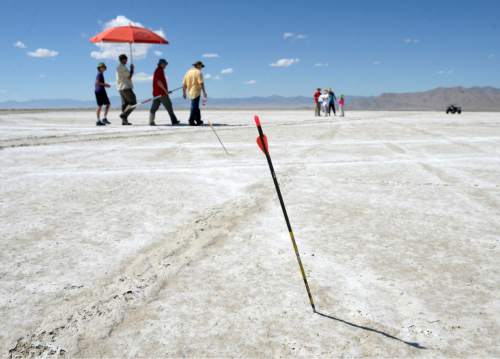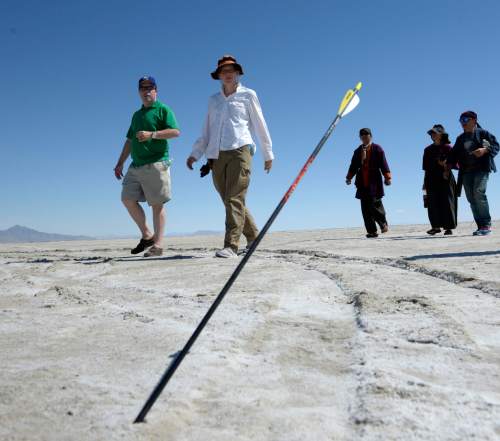This is an archived article that was published on sltrib.com in 2016, and information in the article may be outdated. It is provided only for personal research purposes and may not be reprinted.
Bonneville Salt Flats • If you're into cars, then Utah's famous salt flats are synonymous with speed. But the archers set up there now will spend most of this weekend waiting.
Yet there are moments of triumph interspersed through the long arrow-retrieval periods that the event's captain, Brigham City resident David Hayes, likened to watching paint dry.
"Oh man, this is exciting — I'll do even better this afternoon," Jim Martin, an archer from New Mexico, exclaimed after one of his Friday-morning shots — which he said was likely a personal best.
Unlike more familiar feats that focus on accuracy, the aim of flight archery is essentially to shoot an arrow as far as possible. The sport is not particularly large — this weekend's event is one of the largest in recent years, with 31 archers entered. Typically, the event — held on the Bonneville Salt Flats over Labor Day for close to two decades — attracts about 15 archers, said Kay Koppedrayer, secretary treasurer for the USA Flight Archery Committee.
But the sport is growing, thanks to the popularity of "The Hunger Games" and other recent pop-culture archers, Koppedrayer said. And the interest runs wide — archers from all over the world were here Friday, including a team from Taiwan that is taking aim at a world record for small "primitive"-class bows with a 600-year-old technique.
The Taiwanese trio uses hand-crafted bows to mimic an ancient form of archery from Mongolia they've seen depicted in pictures. Jang Wuhua builds the bows, while archers Hsu Jack and Hsiau Yifan perfect their technique and assist with historical research.
"We want to find out what exactly this ancient art is like," Hsu said.
They were also looking to break a record — and this competition is the best place to do that, Jang said, because the competition's fastidious accuracy is world-renowned.
"And the site is perfect," he said, "the best in the world."
The perfection of the site has some flight archers, including Larry Hatfield, backing an initiative intended to push the Bureau of Land Management to deed a few miles of the salt flats to the U.S. Flight Archery Committee. The land would remain public and be managed by the BLM, Hatfield said, but having a deed would guarantee the archers the right to hold their event on the flats for perpetuity.
The wide-open salt flats are free from vegetation that can impede an arrow's flight and hide its landing spot.
"The problem with long-distance archery isn't finding a place to shoot long distance," said Bede Dwyer, an archer from Australia. "It's finding a place where you can find the arrows."
In the interest of verification, competitors must adhere to strict rules. Bows and arrows must be weighed and inspected to ensure they meet the requirements for the class in which they'll compete. To guard against post-inspection tampering, the equipment is stored in quarantine when not in use.
The competition itself is broken into rounds in which the archers are given just a couple of minutes to shoot up to six arrows each. Only the archers and their coaches — one coach per archer — are allowed inside the roped-off box from which the arrows are launched.
This is for safety purposes as much as to prevent cheating — one competitor's bow string sliced open her hand at the beginning of Friday morning's round.
After the arrows are launched, only the competition's retrieval committee is permitted to handle the waiting arrows. They locate one arrow at a time and use surveyors equipment to measure its distance from the start line. Distance is measured on a right angle, as though the start line continues on in perpetuity in either direction. This means that if an arrow isn't shot in a perfectly straight line, its diagonal flight path from the point of origin won't garner it any additional distance.
While the archers wait for their measurements, the conversation turns to topics such as physics, history, and bow construction. Flight archery, they say, is a sport for nerds.
It was archaeologist Candace Sall's day job as a curator at the University of Missouri's Museum of Anthropology that first introduced her to flight archery. That museum, she said, has one of the largest collections of bows and archery equipment in the world, and would draw archers looking to study bow design. In the course of conversation, Sall was eventually invited out to the salt flats to give flight archery a go and, on her first try, more or less accidentally set a world record by using a small primitive bow to shoot an arrow 800 feet.
That was in 2014. Two years later, Sall is still looking to best her first, accidental shot — Friday's efforts left her short again.
The Taiwanese archers also concluded the morning with a bit of disappointment. Hsu was more than 100 feet short of his goal.
Dwyer, who was experimenting with ultra-light arrows of his own make, fared better. In theory, he said, the lighter the arrow, the farther it will fly. But if the arrows aren't made just right, he said, they'll shatter from the force of the bow without taking flight. He was worried before Friday morning's round, but the arrows went farther than he'd expected. With confidence boosted, he said he'd try them on a larger bow for even greater distance in later rounds.
Spirits remained high throughout a late Friday lunch, even among those whose arrows flew short. There were, after all, three more rounds to go before an awards ceremony would wrap up the flight archery competition Saturday evening.
Twitter: @EmaPen


